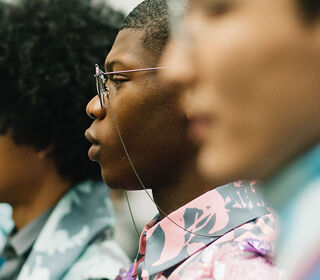
Opinion

Harry Styles’ recent Vogue cover, in which he was photographed wearing a dress, sparked debate across social media and beyond about masculinity and gender fluid fashion. Styles recently hit back at critics in an Instagram post, referencing Amercian conservative commentator Candace Owens’ please to ‘bring back manly men’.
Lecturer Laura Arrowsmith reflects on the changing face of gendered fashion and what that could mean for leading retailers.
There has been recent controversy around One Direction star Harry Styles on the front cover of Vogue dressing in what society labels ‘women’s clothing’. It has gained media attention and public debate with some viewers arguing that it ‘isn’t manly’.
I believe as a society we are evolving and understanding that we don’t have to slot into a particular mould, we don’t have to be labelled a certain way or be defined by a particular gender.
We have seen icons such as David Bowie, Iggy Pop and Kurt Cobain all wearing dresses in the past, which don’t define them as a person but simply showcases a form of expression.
The recent Vogue images of Harry Styles, if anything, are a representation of exploration, gender fluidity and non-binary dressing, which shouldn’t be criticised but simply highlighted as a way of playing around with shapes and styles. Nothing more, nothing less. And certainly not a way of belittling someone by saying they are any less of a man. I think there’s such a stigma around this which is ironic considering we are of an era where we strongly champion gender equality.
I think as a society we are evolving and understanding that we don’t have to slot into a particular mould, we don’t have to be labelled a certain way or be defined by a particular gender. It shouldn’t be about being male or female it should be about who you want to be, what makes you happy as an individual rather than labelling yourself and placing yourself within a box.
I think to define fashion it’s not about being trendy or following the latest looks it’s about enjoying clothing, being influenced by your own personal journey and as a form of expression rather than being solely dictated to.
Retailers such as ASOS, River Island and John Lewis are among a small selection of retailers who have introduced gender neutral collections. However, there is plenty of work still to do around this. Creating collections of muted tones and baggy t-shirts doesn’t cut it, retailers need consider what ‘gender neutral’ really means and I’m looking forward to this movement.




